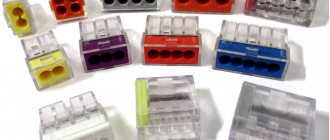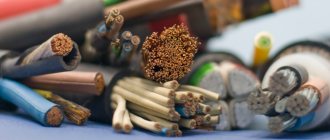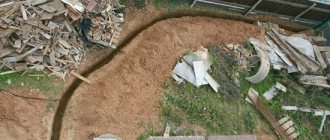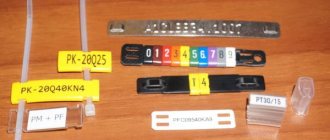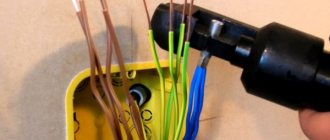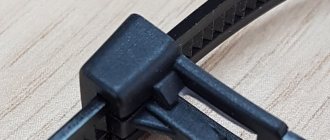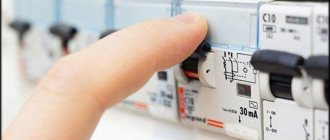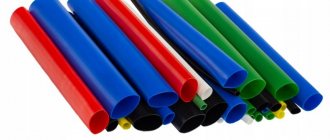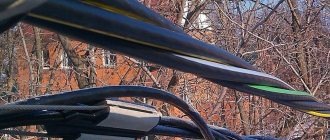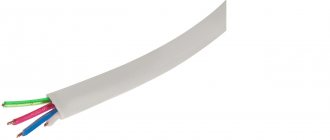The use of plastic pipes for electrical wiring
HDPE pipes for electrical wiring are considered a new generation of materials that have a number of undeniable advantages compared to metal pipes.
HDPE pipes for cable have the following advantages:
- high resistance to corrosion and chemicals;
- long service life (up to 50 years);
- low weight, making such pipes easy to transport and lay;
- there is no need for additional wire protection;
- moisture that gets inside the pipe will not begin to destroy it from the inside;
- small cross-section pipes bend easily;
- relatively low cost of material;
- you can assemble a ready-made system without having any special knowledge or skills for this type of work.
Smooth PVC electrical pipes are made by continuous extrusion and are characterized by low linear expansion, rigidity and stability. Such pipes are ideal for laying electrical wiring in concrete structures. There are PVC pipes with sections of 16-50 mm, although their length does not exceed 3 meters.
Smooth pipes are designed to protect the cable from mechanical damage. They can be laid as open wiring on the ceiling made of low- and non-flammable materials. There are many types of PVC pipes: rigid, smooth, reinforced and corrugated. And they all differ in their own characteristics, which will be relevant in each individual case. For example, pipes with smooth walls are used for laying and protecting wires in the walls of residential buildings, as well as administrative and industrial structures. Their main goal is to obtain an extremely reliable electrical wiring system.
Smooth single-wall HDPE pipes are suitable for pouring concrete, as well as for laying them in brick walls. They are connected using special tees, couplings, bends, and so on.
Positive qualities of such pipes:
- service life of at least 50 years;
- are not afraid of low temperatures;
- the cross-section of the pipes does not change during the entire service life, no deposits accumulate on the internal walls, and moisture does not collect on the external walls;
- excellent smooth pipe surface that does not need to be treated or covered with paint;
- do not pose a danger to the environment, plus they are very easy and safe to work with;
- light weight and reasonable price.
Scope of use of pipes for electrical wiring
Just 10–15 years ago, conductive wires were hidden in pipes only in cases where they needed to be protected from mechanical, chemical or thermal effects. Pipes were used to create a common entrance to a building, when laying cables in the ground at shallow depths, and when electrifying buildings with high fire safety requirements.
Properly laid conductive cable
According to modern building codes, all conductive cables, regardless of the thickness of the insulation and the cross-section of the core, must be hidden in pipes of suitable diameter. This rule not only ensures the safety of the wiring, but also helps to avoid fire in the event of a short circuit. Pipes are used in warehouses, industrial buildings, residential individual and apartment buildings. The only exceptions may be rooms with open wiring and low fire safety requirements.
The main functions of electrical wiring pipes:
- Protection of cables from mechanical shocks . The integrity of the wire hidden in the plaster may be compromised when installing hanging shelves or creating a new opening in the wall. If the wire is in the pipe, the likelihood of this damage will be much lower.
- Protection of wiring from moisture . For example, if the apartment is flooded by neighbors from above, the wires embedded in the ceiling will fall into a humid environment and if they are not protected, then a short circuit may occur in connection points and areas with damaged insulation.
- Fire prevention . The tube will not allow the fire to affect neighboring areas or will significantly limit its intensity (depending on the material of the product). In wooden houses, this is an effective way to delay a fire and enable owners to prevent a fire.
- Easy to repair . If the wire leading to the outlet is damaged, you will not need to trench the walls to restore its operation. The technician will simply disconnect its end in the junction box and, attaching the edge of a new cable to the free end, will stretch them to the outlet through the pipe. As a result, the old cable will be completely pulled out, and the new one will only have to be connected to the contacts. The whole job will take no more than 30–40 minutes and will cost tens of times less than redoing the entire wall.
The difference between cables and wires depending on the core material
Cores of wires and cables for specialized purposes can be made of various metals, but aluminum and copper are mainly used in electrical engineering. Each of them has its own specific properties, advantages and disadvantages, which must be taken into account when selecting a core material for a specific purpose.
Aluminum conductors
The invention of a relatively inexpensive method for extracting aluminum made a revolution in the global development of electrification, because in terms of electrical conductivity this metal ranks fourth, behind only silver, copper and gold. This made it possible to reduce the cost of production of wires and cables as much as possible and make universal electrification a reality.
Such electrical wires and their types are distinguished by their low cost, chemical resistance, high level of heat transfer and low weight - they have determined the mass of electrification in industrial and domestic conditions for more than half a century.
In light of the relatively recent dominance of aluminum in the wire market, it may seem strange to the uninitiated that the provisions of the PUE prohibit the use of this material in everyday life. More precisely, you cannot use aluminum wires with a cross-section of less than 16 mm², and these are the most common of them for installing home electrical wiring. To understand why there is a ban on the use of these wires, you can familiarize yourself with their advantages and disadvantages.
+ Advantages of aluminum wires
- Lighter than copper.
- Significantly cheaper.
— Disadvantages of aluminum wires
- Aluminum conductors with a cross-section of up to 16 mm² can only be single-wire, which means they can only be used for laying stationary wiring and without bending at an acute angle. All flexible wires and cables have always been made of copper.
- The chemical resistance of aluminum is determined by the oxide film that forms when it comes into contact with air. Over time, with constant heating of the contact due to the flow of electric current through it, this film deteriorates electrical conductivity, the contact overheats and fails. That is, aluminum wires require additional maintenance, and the contacts through which powerful currents pass are coated with a special lubricant.
- Amorphous material - if you clamp two aluminum wires together, the contact will weaken over time, as the aluminum will partially “leak out” from under pressure.
- Soldering can only be carried out using special tools, and welding can be performed in a chamber with an inert gas.
- Good electrical conductivity is observed only in pure aluminum, and impurities inevitably remaining during production worsen this indicator.
As a result, aluminum is a good choice if you need to save money here and now, but in the long run its use will be more expensive due to its relatively short service life and the need for regular maintenance. For this reason and additional safety reasons, the PUE strictly prohibits using it for laying new power lines.
Copper conductors
In terms of electrical conductivity, copper is in second place, only 5% inferior to silver in this indicator.
Compared to aluminum, copper has only 2 significant disadvantages, due to which for a long time it was used much less frequently. Otherwise, copper wins in all respects.
+ Pros of copper wires
- Electrical conductivity is 1.7 times higher than aluminum - a smaller cross-section of wire will pass the same amount of current.
- High flexibility and elasticity - even single-core wires can withstand a large number of deformations, and multi-core wires make cords for electrical appliances with increased flexibility.
- Soldering, tinning and welding are carried out without the use of additional materials.
— Disadvantages of copper wires
- The cost is several times more expensive than aluminum.
- High density - a coil of copper wire, the same length and cross-section as aluminum, will weigh 3 times more.
- Copper wires and contacts oxidize in open air. However, this practically does not affect the contact resistance and, if necessary, is “treated” by lubricating the surface of the already tightened contact.
As a result, although copper is a more expensive material, in general its use is more economical, since it is more durable, requires less effort during installation and attention during maintenance.
Selection of metal pipes for cable laying
The electric cable can be laid in almost any pipes.
The minimum requirement for the casing is the absence of rust, burrs and internal irregularities.
Metal pipes are selected according to various parameters: price, decorativeness
Pay attention to the resistance of pipes against corrosion, as well as how easy it is to install the system
- The most decorative are copper and brass pipes; they cope better than others with the task of decorating electrical wiring laid in an open way and do not require painting. At the same time, thin-walled pipes allow the casing to be given any necessary shape without the use of shaped elements, while thick-walled pipes can further emphasize the deliberate roughness of the communication by assembling the pipeline using fittings.
- Stainless steel pipes are the most expensive, but reliable and easy to install: they do not need to be painted, they are smooth inside and out, do not corrode and are suitable for laying cables in any way.
- Galvanized ones have the same advantages as stainless steel ones, but their price is lower, so galvanizing is often preferred. However, the service life of galvanized pipes is half as long.
- Steel pipes that do not have a protective coating and aluminum pipes will need to be painted inside and out before installation to prevent oxidation. If an electrical cable in a steel casing is laid in a cement screed, the outer surface of the pipe does not need to be painted.
- Corrugated pipes are easy to install as they easily take on the required shape. Their disadvantage is a weak level of cable protection from compression and impact, so corrugation should not be used for underground communications and in rooms where the risk of strong physical impact is high.
In construction stores you can choose consumables for laying electrical cables to suit every taste. But pipes remaining after the dismantling of a gas or water supply system are also suitable.
It is important to first inspect the future casing and assess its condition: if the pipes do not have cracks, internal seams or other irregularities, they can be used. If the pipe does not have a protective coating, it must be painted. Painting is done from the inside by pulling a sponge with paint or pouring paint into a vertical pipe
Painting is done from the inside by pulling a sponge with paint or pouring paint into a vertical pipe
If the pipe does not have a protective coating, it must be painted. Painting from the inside is done by pulling a sponge with paint or pouring paint into a vertically located pipe.
Pipes used, reasons for their popularity
One of the most popular options for laying wires is to place them in the ground. To implement this method, special pipes are used.
Reasons for popularity:
- When placed above ground, the cable may be damaged by a gust of wind, and the method described above does not have such a drawback.
- The underground wire is much more difficult to damage, and there is also protection from external weather conditions.
- Even if the wire is short-circuited, there will be no fire due to the protection.
There are five types of pipes designed for laying cables:
- Polypropylene . This material is characterized by plasticity and heat resistance. Such pipes are easy to give the desired shape.
- Steel . Such pipes are not used for laying power lines in the ground. As a rule, a steel pipe for cable is used indoors, using corrugation.
- Made from high and low pressure polyethylene . This type of pipe is lightweight, durable and has a long service life, and it also has corrosion protection.
- Asbestos-cement . These are heavy pipes and contain asbestos, which is harmful to the human body.
- PVC pipes.
The greatest demand at the moment is for pipes made of low-density polyethylene (abbreviated as HDPE). There are a huge number of varieties of such products: smooth-walled rigid, double-walled, corrugated pipes and so on.
Corrugated pipes for laying cables in the ground have high elasticity, as well as heavy weight due to the reinforcing mesh inside. In addition to corrugation, double-wall pipes contain a layer of HDPE.
One of the main advantages of laying the cable inside such a product is that it will be completely hidden from the environment. The pipes are durable; the manufacturer claims that they can last up to 50 years. In reality, this period turns out to be higher.
Why water pipes are not suitable for cable
You may have repeatedly seen how cable laying (for example, to the distribution panel of a private cottage) is carried out in the ground using pipes for process water. So, this is far from the best solution.
Polyethylene pipes for process water are not advisable from the point of view of safety and economy
The truth is that water pipes, if they are without water, burn very quickly (when they are used as expected, with water, then, of course, they do not burn). Immediately a solid argument “against”. In principle, it is possible to lay cables in water pipes, but only if the entire structure is buried underground. In this case, there is no oxygen, which means there is no danger of combustion.
What about mechanical protection? There is also a big question here. Electrical cable pipes are designed to withstand external pressure in the form of compression. But water pipes maintain the pressure of water from the inside, so they are made to be resistant to pressure - this is a completely different specificity and, accordingly, design.
It should also be noted that this method is economically inappropriate. The fact is that the cost of pressure water pipes is higher than electrical installation ones.
In general, water pipes are not used for wiring because:
- they are more expensive
- they are flammable.
But if you have an extra ten meters of water supply, you can bury it with a cable to the nearest outbuilding on your summer cottage. But the electrical installation is still an order of magnitude better for laying in the ground, because it is strengthened precisely from the process of squeezing from the outside.
Don't need such a dubious compromise? Then you will have to choose from the originally intended options to lay the cable in the pipes.
Why do we need pipes for wiring?
Renovating and changing the style of your home is a complex process that requires a lot of money and time. Another difficulty is that you may not understand everything. For example, why, in addition to the pipes themselves, are so many other parts needed? We will try to explain everything and make the purchasing process easier.
If everything is clear with pipes, we know their function, then the rest of the words seem foreign.
For example, a coupling. This product is used to connect wires into a single line and also protects them from damage. Moreover, it is capable of connecting not only similar sections of cable, but also those of different structure and shape. These functions explain the variety of classifications of such devices. In our catalog we have a regular and a transition coupling. They are made of either steel or copper. Both of these materials are highly durable.
What is a fastener? This is a small device that allows you to attach wires not only to each other, but also to various surfaces. It is made of metal. Fasteners made from this material are considered the most reliable. It is used for pipes of any size.
A fixation clip is a type of fastening. It consists of two parts, one of which is inserted into the other. It is clamped with special latches. This product is excellent for joining plastic pipes.
Double-sided fastener - a U-shaped part with two places for fastening. Suitable for all pipes of different sizes.
The remaining elements presented in our store are important devices for not only connecting pipes, but also directing them in the desired direction and quantity. For example, a tee allows you to make a triple branch, and a bypass allows you to install the pipe so that it does not touch another important device.
Pipes for wiring are available in several shades:
- bronze;
- silver;
- copper;
- silver Age.
This is an original product from the brands Retrika and Bironi.
Types of clips for fastening wires
When installing open wiring, attaching a wire or cable to the ceiling or wall can be done in various ways. One of the frequently used installation options is based on the use of special fasteners - clips.
Depending on what kind of conductor needs to be laid, whether it is fastened in a pipe, a corrugated sleeve, or openly, whether there are requirements for the appearance of the wiring, clips for wires and cables are used, having different designs and sizes.
Below is an overview of these mounting products.
Clips for mounting corrugated or PVC pipes
In the case when a cable or wire is laid in a corrugated or PVC pipe, it is convenient to use elastic plastic clamps - latches, shown in the photo:
They are made by plastic injection molding and are equipped with stiffening ribs that ensure grip strength on the pipe or corrugation. The use of high-quality plastic allows the product to maintain mechanical characteristics over a wide range of operating temperatures.
Fastening is done with a self-tapping screw. The size range is represented by clips with installation diameters from 12 mm to 50 mm.
A special feature of this product is special grooves on the side surfaces of the clip, thanks to which clips of different sizes can be combined into blocks when parallel laying of several cable lines is necessary.
You should begin work by carefully marking the wiring route. Clips or blocks of them must be attached at equal distances.
If several lines are laid in parallel and the clamps are combined into blocks, there is no need to attach each of them to the wall; it is enough to secure one of the three or four connected clamps.
Depending on the material of the wall or ceiling, the clamp can be attached either by directly screwing in a screw (for wood or drywall) or into a pre-drilled hole (for metal or plastic).
For installation during installation of a cable clamp on brick or concrete, it is better to use a dowel-nail of the required size. The installation ends by installing the pipe into the latch and lightly pressing until it enters the groove, accompanied by a click. We described in more detail how to route the cable through the corrugation in a separate article.
The photo below shows a version of a clamp that secures sealed pipes or corrugations. It is equipped with a clasp that provides a tighter fit. This clamp, like the previous one, is installed under a screw.
Scope of application of pipes for installation of electrical wiring
The choice of method for laying wires is regulated by clause 2.1 of the PUE. It stipulates the conditions for electrical and fire safety of electrical wiring. And if you are going to install wires, then the choice of method must meet both of these requirements.
The photo shows various options for using pipes in electrical engineering
So:
- According to electrical safety conditions, non-metal pipes can be used for open wiring installations for outdoor installations. In addition, they can be used as additional protection when laid in construction channels or under a layer of plaster when installing hidden wiring.
- Steel pipes can be used as additional protection, according to Table 2.1.2 PUE, in almost any cases. The only exceptions are particularly damp rooms, as well as installation of external wiring.
- But in terms of fire safety, everything is much more complicated. It all depends on the surface on which installation is to be carried out. It can be a combustible or non-combustible surface, or a hard-to-burn surface.
- A steel pipe for electrical wiring must be used for open installation on combustible surfaces if a wire or cable is used without additional protection. If installation is carried out on fireproof surfaces, then the use of non-metal pipes is sufficient.
- When installing hidden wiring on combustible surfaces with unprotected wires, it is also necessary to use a steel pipe. If a plastic pipe is used, then a lining must be provided between it and the base of fireproof material.
Note! The fireproof material that is placed between the pipe and the surface must protrude from all sides of the pipe to a distance of at least 1 cm.
- Non-steel pipes for electrical wiring can be used for hidden installation on fireproof structures. Moreover, if the pipe is made of combustible materials, it must be additionally plastered.
Application of thin-walled pipes
A few words about the specifics of products of this type. Since we are talking about technical products, its definition should contain numbers, and not a subjective assessment of belonging to one class or another. So: the range of thin-walled steel pipes includes products with a wall thickness of no more than 1.5 millimeters or if the value of the coefficient determined by the formula
Din. is the outer diameter, and S st. – wall thickness, lies in the range of 12.5...40.
A good example of the use of thin-walled metal products includes pneumatic and hydraulic drive systems in the automotive, aviation and shipbuilding industries.
Of course, the above-mentioned area of application for thin-walled steel pipes is far from the only one. They can be found in such industries as:
- construction;
- housing and communal services sector;
- furniture manufacturing;
- boiler houses of energy enterprises.
Architectural elements or decorative items can be made from steel pipes
In everyday life, these products are also not uncommon. But here they are most often used when engineering communications must have moderate strength, sufficient to withstand only low loads. In this case, we are talking primarily about a thin-walled steel pipe for electrical wiring.
Corrugated pipes
On sale you can even find varieties of such pipes with very large sections that are laid in concrete or cement screed.
Recommended pipe sizes for various purposes are:
- for installation of switches and sockets – 20 mm;
- for installation of lighting elements – 16 mm;
- laying a line between the boxes and distribution panels - 25 mm;
- for making connections between floors – 40 mm.
Let us note the most significant advantages of corrugated pipes for home use:
- electrical wiring will be reliably protected from mechanical damage;
- possibility of quick installation without additional elements;
- non-flammability of the material - thanks to this, the risk of fire of wires is eliminated;
- high-quality insulation of electrical wires;
- the flexibility of the pipe allows you to create a line of any configuration, passing along the shortest path.
Characteristics of electrical PVC pipes
The electrical pipe is made of self-extinguishing polyvinyl chloride and high and low pressure polyethylene. These materials are endowed with technical characteristics that allow the installation of pipes of this type to create cable support systems. In addition, the PVC electrical pipe serves as an additional layer of insulation for the cable, provides fire resistance and protects the wiring from mechanical damage.
Advantages
PVC pipes have a number of undeniable advantages:
- durable: they have original strength, are not subject to corrosion, are resistant to humid and aggressive environments, and to ultraviolet radiation;
- hygienic and environmentally friendly;
- easy to install: lightweight, easy to saw, glue, solder;
- have a low deformation coefficient;
- do not bear a significant load on the structure;
- provide (with appropriate accessories) complete tightness, in which the cable is reliably protected from the penetration of dust and moisture;
- practical: they have a low price, during operation they do not require painting or other maintenance.
The principle of laying cables in a groove
In addition, cable installation with their use is carried out quickly and efficiently, this is facilitated by the absence of roughness on the inner wall of the pipe. Such systems are practical to use, since the electrical wiring in them is replaced without the need to open the trench and dismantle the ceiling.
Due to these qualities, PVC pipes for cable laying have no alternative today. They are an indispensable component of power supply systems and are successfully used in the construction of residential, industrial and administrative facilities.
PVC electrical pipe is non-flammable, it has the highest fire safety category among polymer analogues.
Varieties
Electrical PVC pipes are usually divided into two main categories:
- smooth hard (smooth-walled);
- corrugated (flexible corrugated pipes).
Rigid PVC pipe for cable is used mainly outside building structures, corrugated pipe is used when laying electrical supply systems inside ceilings (under plaster, in a floor screed, etc.).
Also, their classification is determined according to GOST 18599-83, which distinguishes 4 categories of electrical pipes:
- T – heavy;
- C – average;
- SL – medium-light;
- N – non-standard.
They can be produced with different diameters: 8 ÷ 250 mm; with different wall thicknesses and different colors.
Smooth and corrugated PVC electrical pipes in different colors
The corrugated PVC pipe with a probe for cable pulling deserves special attention. The advantageous feature of this model is the presence of a special rigid steel wire, which greatly facilitates the process of installing the wire inside the cable support system.
The corrugated pipe is attached to the supporting planes using special latches-clips, which are easily detached if it is necessary to change the direction of the cables or move part of the wiring to another place.
Corrugated pipe PVC pipe with broach for cable laying
Regulatory documents
Characteristics of copper decorative pipe and additional elements for electrical wiring
The technology of electrical installation work is regulated by a unified set of building codes and regulations, which are mandatory for any organization, production or department.
The following provisions serve as regulatory documents:
- PUE (edition No. 7) - rules for the design of electrical installations for new and reconstructed buildings with equipment operating at voltages up to 500 kW.
- SNiP (2.08.01–89, 2.09.04–87) – regulations that prescribe general provisions, design standards, installation and work acceptance rules.
- PTB (153–34.0–03.150) – safety rules when carrying out electrical installation and debugging work.
The production of steel electrical pipes is regulated by GOST No. 10704–91, 10706–76 and the international standard CEI EN No. 50086–1. GOST contains a complete list of characteristics and technical requirements for the product.
The technical and operational characteristics of rigid smooth PVC pipes are regulated by the interstate standard adopted in 2014 - GOST 32126.1–2013. The old GOST 50827–95 is no longer valid.
Advantages and disadvantages of laying in the soil
Advantages of laying power lines in the soil:
- The soil serves to a certain extent as mechanical protection of communications - when laid underground, hurricanes, ice, snow, wind, and the movement of large vehicles are not afraid.
- Sometimes overhead installation is simply impossible - if there is a highway or geological obstacles in the way).
- Neither ill-wishers nor thieves will damage communications; will not be chewed by rodents and will not be damaged by a cluster of sitting birds.
- In the event of a break or short circuit, the earth serves as a grounding conductor - this reduces to a minimum the fire of wiring in the house, the contact of voltage on the building structures and engineering systems (this will protect a person in the event of an accident from injury from electric shock).
- Invisible communications do not spoil the design of the site. This is especially true when distributing lighting around the site or the entrance to the site.
Flaws:
- Excavation work increases the cost of laying communications, requires time, labor and certain efforts to restore the soil surface - the excavated soil will settle for several years. If the mound is leveled, then in a couple of years a groove will appear in place of the trench.
- Laying in pipes is more difficult and more expensive than hanging a cable through the air.
- Pipeline installation also complicates the work.
- When turning communications, you will have to equip a well.
- The most unpleasant thing is that if a cable is damaged, replacing it is quite complicated, takes time, and sometimes is simply impossible (for example, when the soil freezes to a significant depth, it is impossible to dig a trench manually, and digging with an excavator on the site means damaging plantings, sites, possibly a fence or buildings).
Materials for the manufacture of tubes for electrical wiring
The choice of material from which the channel is made depends on the type and characteristics of the room where the wiring is planned.
Pipes can be made from:
- plastic;
- copper;
- brass;
- become.
In the manufacture of plastic products, polyvinyl chloride (PVC), high-pressure (HP) and low-pressure (LP) polyethylene (D) are used. Products made from polyvinyl chloride are in high demand among consumers because they have an affordable price and are characterized by good strength and resistance to high temperatures. The most common PVC pipes have a diameter of 16 to 60 millimeters.
Plastic products have a smooth inner surface, and this feature makes it easier to carry out work related to replacing conductors. They are also lightweight and resistant to corrosion. In addition, channels made of polyethylene and polyvinyl chloride are dielectrics and therefore can be considered an additional insulating circuit.
Brass or copper thin-walled tubes are suitable for installation on wall surfaces and for concealed wiring. Such products bend easily and do not require decorative design.
Plastic or metal? - that is the question
The choice depends on what kind of wiring and under what conditions you plan to carry out. And it also requires relying on the standards prescribed in the PUE. But these are general words, so I’ll go straight to the specifics.
Metal pipes are practically not used in electrical installations
And this is the first thing you need to know. Pipes made of stainless or galvanized steel, aluminum, and brass are becoming less and less common on sale; they are becoming much less in demand and becoming a thing of the past. Mainly due to the inability to compete in cost with plastic analogues with approximately the same performance characteristics.
Where you cannot do without metal hoses is when installing electrical networks in fire hazardous areas: both indoors and outdoors (PUE, Chapter 7.4 “Electrical installations in fire hazardous areas”).
In a wooden building, a galvanized metal hose is required for electrical installation
The work is labor-intensive and financially expensive, but when organizing electrical wiring in a house made of wood, “the game is worth the candle” - or rather, your peace of mind is worth a lot.
That is, a metal hose is more than justified when installing cables in wooden houses, warehouses, and industrial premises where there is an increased risk of fire. But polyethylene, as a flammable material, is categorically not recommended. But it is recommended in most other situations.
Read more about the benefits of plastic pipes
Most often, PVC (polyvinyl chloride), polypropylene, HDPE and LDPE (low or high pressure polyethylene, respectively), polyamide (the highest level of stability and price) are used for their production. They are produced in two types - rigid and corrugated. Advantages of plastic systems:
- survivability (with proper operation up to 30-50 years),
- lightness of the design itself, as well as ease of installation,
- mechanical strength,
- corrosion resistance,
- wide range of sizes and mounting accessories.
To make it easier to understand where and which pipes are appropriate, we will distribute them by area of application.
Resistance to combustion is a mandatory quality for indoor electrical installations
Smooth PVC pipe
Basically, corrugated and smooth PVC (polyvinyl chloride) pipes are laid for wiring inside buildings. The main advantage of this material is that it does not support combustion. Including due to sealing using couplings during the installation process. Combustion is impossible where there is no oxygen supply.
However, PVC quickly deteriorates and cracks when exposed to sunlight, and therefore is not used for external installation work. What is used? See below.
External electrical wiring requires different solutions
Here you cannot do without pipes made of low-density polyethylene (HDPE) or polyamide. These are materials that are resistant to frost, moisture, aggressive substances and ultraviolet radiation. They protect the cable from damage during installation and perform the function of fire protection.
HDPE corrugation with broaching probe
Pipes that are visually suitable for outdoor placement are produced in black, as they are minimally susceptible to the destructive effects of ultraviolet radiation.
What if you put it in the ground?
When laying in a trench, it is best to use polyethylene (again, HDPE), and double-walled (two-layer). Why double wall? The outer corrugation helps to achieve high strength and the ability to withstand high loads, and the inner smooth surface ensures quick and easy cable pulling along the entire length.
Double-walled protective red corrugation in a bay
Often pipes for laying in the ground are made in orange or red, which makes sense. The bright color catches the eye and makes it clear that the cable is laid in pipes here, no digging or drilling!
There are two types on sale: non-reinforced and reinforced (more durable, since steel wire is used in their construction). The latter are laid in areas with potentially high compressive loads. As for diameters, when installing in cottage and summer cottage areas, a diameter of 40-50 mm is often sufficient, and for industrial facilities up to 200 mm.
For convenience and clarity, I will collect recommendations in the form of a table
Recommended pipe materials depending on the method of electrical installation
Is it even possible without a pipe? It is possible (read the specific conditions in the PUE), especially if armored cables with high waterproofing characteristics are laid in trenches. BUT it is irrational: laying a simple cable in a protective pipe will cost less than special armored grades.
Features of HDPE pipes
Features of using HDPE pipes:
- HDPE pipes have very simple installation;
- Corrugated pipes are suitable for laying electrical network cables;
- If the installation is done correctly, the pipes form a tight connection;
- HDPE pipes return to their previous linear size over time. The use of a probe allows you to simplify cable pulling.
- HDPE pipes have a high elasticity index (more details: “HDPE pipes - application and technical characteristics”). Therefore, they can be used all year round; changes in soil temperature will not affect them.
For laying signal or power cables, double-wall corrugated pipes are optimal. Their use allows you to protect the line from any external influences.
There are two different types of pipes in the manufacture of which low-density polyethylene was used: products that comply with the GOST standard, and other products from the secondary market. The second option is of worse quality. You can choose it if your budget is limited.
Advantages of low pressure polyethylene pipes:
- Long service life (manufacturers claim 50 years);
- No welding is required to connect individual pipes;
- Lightweight design;
- Over time, the product does not lose its performance characteristics;
- External factors do not have a negative impact on HDPE pipes;
- To lay cables in such pipes, no additional grounding is required;
- Wide range of operating temperatures - from -25 oC to +70oC;
- HDPE pipes do not have a negative impact on the environment, as they do not emit toxic waste or condensate;
- Pipes made of low-pressure polyethylene are easily deformed; there is no need to use additional fasteners and connecting parts to lay the pipeline. But you should understand that if the pipe is strongly bent, the cable will not fit into it.
HDPE pipes are gaining increasing popularity in various areas of life. This is due to the abundance of their advantages without harm to the environment. If you approach the installation and installation process correctly, the object will last for several decades without the need for repairs. They also use HDPE pipes for electrical wiring in the house (for more details: “Characteristics of PVC pipes for electrical wiring, advantages and rules of use”).
Some installation rules
Before installing a cable route made of thin-walled metal pipes for electrical wiring, you should familiarize yourself with the following rules:
the ends of each piece of products need to be pre-cleaned from burrs and countersinked; the maximum permissible bending angle of the steel channel is 90 degrees; there is a limitation on the length of the sections: up to 10 meters in the case of a straight pipe, up to 5 meters - if there are 2 bends; When bending, it is important to monitor the integrity of the cross-section of the product; the metal channel must be made as part of the EPS (potential equalization system).
If it is impossible to meet the conditions for choosing the length of the pipes, according to the rules, it is necessary to install a pull-out box without additional joints.
The physical essence of the control system is the need to connect all conductive parts into a single system in such a way as to minimize or completely eliminate the potential difference between them. To do this, it must include:
- grounding device;
- main (D) grounding (G) bus (W), mounted in the electricity metering (U) board (E) or input board;
- All elements of the building's structure are made of metal.
If you adhere to these rules, you can significantly simplify the installation and replacement of electrical wiring.
Application of metal pipe products
When metal pipes are used for electrical wiring, there may be difficulties associated with pulling the cable through them. This can be solved in several ways. The simplest of them is to insert a steel wire into the channel, attach a cable to its end and then pull it inside.
If the pipe is long, then you can place a ball in it, to which a strong ribbon or thread is tied. To make it easier to move, talc is used. A steel wire is attached to the end of the tape and the air compressor pipe is placed in the hole, after which the device is turned on. The ball moves under pressure along the channel and draws the tape or thread along with it. To cut the product, use a grinder or a hacksaw.
To lay electrical wiring to sockets and switches, choose products with a diameter of 20 millimeters, for lighting fixtures – 16 millimeters, 25 millimeters for connecting distribution or switchboards and boxes, and for interfloor connections – 40 millimeters. The length of the channels, as a rule, ranges from 3 to 5 meters.
Installation of cable in PVC pipe
Use of components
The advantage of laying cables in PVC pipes (compared to metal ones) is obvious:
- PVC electrical pipe is cheaper;
- does not require grounding;
- under normal use it can last up to 50 years;
- can be operated at temperatures from –25 to + 700C;
- do not form or accumulate condensation;
- do not require expensive welding;
- do not require maintenance.
In addition, when using these pipes, the cost of the project is significantly reduced; insulation for PVC pipes is not needed, it itself plays the role of protection, therefore the cable can be used in a lightweight design.
For open wiring (walls, ceilings), according to current standards, a smooth PVC pipe is used for cables; for laying cables inside structures made of fireproof materials, a corrugated pipe is used.
When arranging power supply on wooden and other combustible substrates, only metal pipes or metal hose should be used!
To ensure high-quality installation, it is recommended to use additional components, which are selected based on the diameter and model of the pipe. These include tees, connectors, turns, crosses, dowel-ties, clips, etc. Consultants from the Electrical Products Department will help you select all the necessary parts.
Turn, Tee and Connector for Electrical Pipe
It is recommended to work using a building level, this will ensure the accuracy of the location of the system and its normal functioning in the future.
Installation technology
The installation process looks like this:
- Mark the future placement of pipes with electrical cables. In this case, the distance from the heating elements must be at least 0.5 m so that the cables do not heat up. The locations of the panel boxes are also noted.
- Determine the required number of fasteners at the rate of 1 fastener for every 10-15 cm of pipe.
- Prepare all the necessary elements and check that the voltage in the electrical network does not exceed 1500 V.
- If necessary, cut the products into sections of the required length.
- They prepare the products - straighten the wires, and, if necessary, clean the inner surface of the pipes.
- Pull the cable through the pipeline elements, and then install its sections in accordance with the diagram.
Diagram of cable pulling in a pipe system
Installation of the PVC pipeline must be carried out with a slope in order to avoid the accumulation of condensate in it.
- The pipeline is fastened at regular intervals in accordance with the markings.
- Panel boxes are installed in which the cables being laid are connected into nodes.
- Check the reliability of the insulation between the laid wires.
